2007 SUBARU OUTBACK warning
[x] Cancel search: warningPage 383 of 442
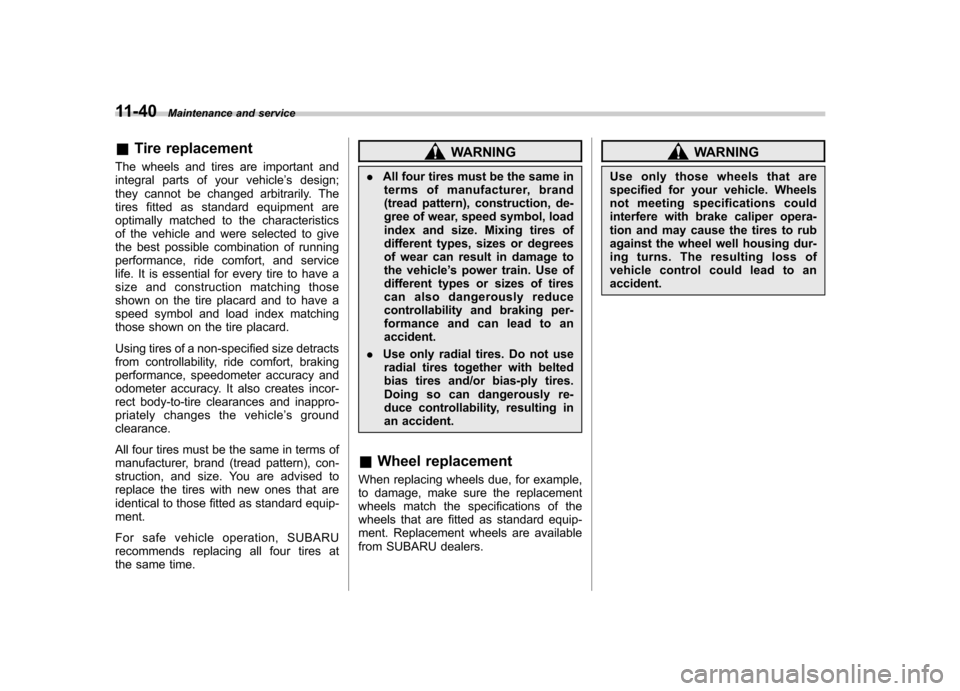
11-40Maintenance and service
&Tire replacement
The wheels and tires are important and
integral parts of your vehicle ’s design;
they cannot be changed arbitrarily. The
tires fitted as standard equipment are
optimally matched to the characteristics
of the vehicle and were selected to give
the best possible combination of running
performance, ride comfort, and service
life. It is essential for every tire to have a
size and construction matching those
shown on the tire placard and to have a
speed symbol and load index matching
those shown on the tire placard.
Using tires of a non-specified size detracts
from controllability, ride comfort, braking
performance, speedometer accuracy and
odometer accuracy. It also creates incor-
rect body-to-tire clearances and inappro-
priately changes the vehicle ’sground
clearance.
All four tires must be the same in terms of
manufacturer, brand (tread pattern), con-
struction, and size. You are advised to
replace the tires with new ones that are
identical to those fitted as standard equip-ment.
For safe vehicle operation, SUBARU
recommends replacing all four tires at
the same time.WARNING
. All four tires must be the same in
terms of manufacturer, brand
(tread pattern), construction, de-
gree of wear, speed symbol, load
index and size. Mixing tires of
different types, sizes or degrees
of wear can result in damage to
the vehicle ’s power train. Use of
different types or sizes of tires
can also dangerously reduce
controllability and braking per-
formance and can lead to anaccident.
. Use only radial tires. Do not use
radial tires together with belted
bias tires and/or bias-ply tires.
Doing so can dangerously re-
duce controllability, resulting in
an accident.
& Wheel replacement
When replacing wheels due, for example,
to damage, make sure the replacement
wheels match the specifications of the
wheels that are fitted as standard equip-
ment. Replacement wheels are available
from SUBARU dealers.WARNING
Use only those wheels that are
specified for your vehicle. Wheels
not meeting specifications could
interfere with brake caliper opera-
tion and may cause the tires to rub
against the wheel well housing dur-
ing turns. The resulting loss of
vehicle control could lead to anaccident.
Page 389 of 442
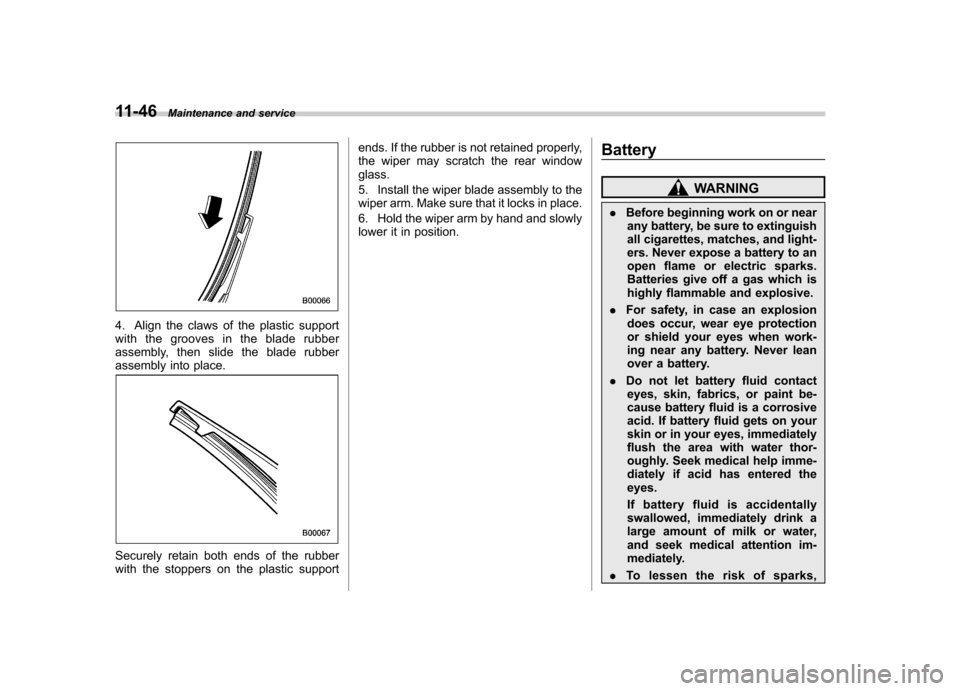
11-46Maintenance and service
4. Align the claws of the plastic support
with the grooves in the blade rubber
assembly, then slide the blade rubber
assembly into place.
Securely retain both ends of the rubber
with the stoppers on the plastic support ends. If the rubber is not retained properly,
the wiper may scratch the rear windowglass.
5. Install the wiper blade assembly to the
wiper arm. Make sure that it locks in place.
6. Hold the wiper arm by hand and slowly
lower it in position.
Battery
WARNING
. Before beginning work on or near
any battery, be sure to extinguish
all cigarettes, matches, and light-
ers. Never expose a battery to an
open flame or electric sparks.
Batteries give off a gas which is
highly flammable and explosive.
. For safety, in case an explosion
does occur, wear eye protection
or shield your eyes when work-
ing near any battery. Never lean
over a battery.
. Do not let battery fluid contact
eyes, skin, fabrics, or paint be-
cause battery fluid is a corrosive
acid. If battery fluid gets on your
skin or in your eyes, immediately
flush the area with water thor-
oughly. Seek medical help imme-
diately if acid has entered theeyes.
If battery fluid is accidentally
swallowed, immediately drink a
large amount of milk or water,
and seek medical attention im-
mediately.
. To lessen the risk of sparks,
Page 411 of 442
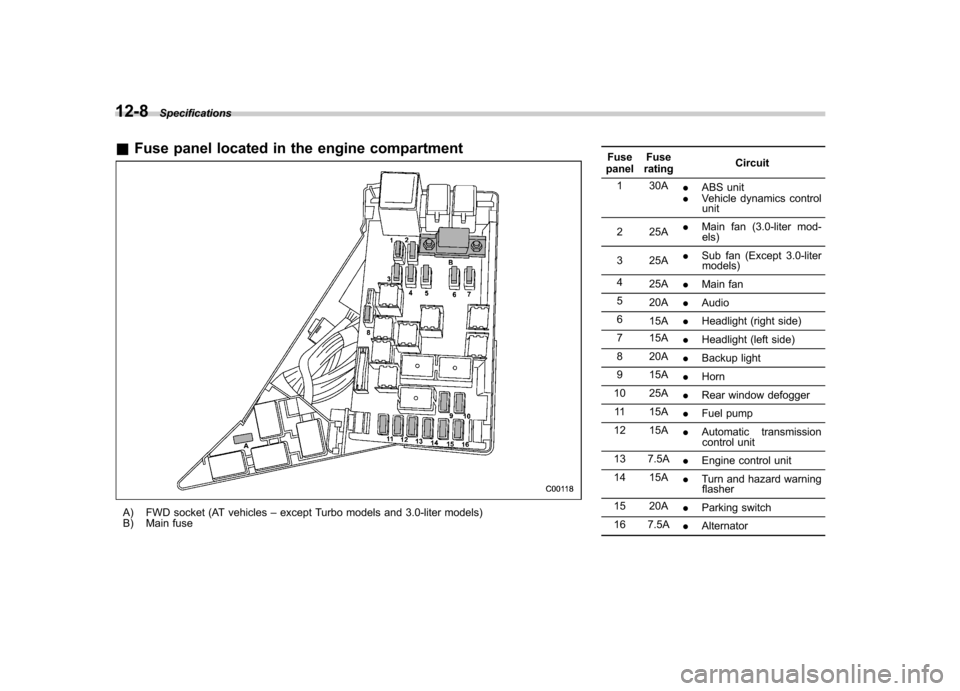
12-8Specifications
&Fuse panel located in the engine compartment
A) FWD socket (AT vehicles –except Turbo models and 3.0-liter models)
B) Main fuse Fuse
panel Fuse
rating Circuit
1 30A .ABS unit
. Vehicle dynamics control
unit
2 25A .
Main fan (3.0-liter mod-
els)
3 25A .
Sub fan (Except 3.0-liter
models)
4 25A .Main fan
5 20A .Audio
6 15A .Headlight (right side)
7 15A .Headlight (left side)
8 20A .Backup light
9 15A .Horn
10 25A .Rear window defogger
11 15A .Fuel pump
12 15A .Automatic transmission
control unit
13 7.5A .Engine control unit
14 15A .Turn and hazard warning
flasher
15 20A .Parking switch
16 7.5A .Alternator
Page 418 of 442
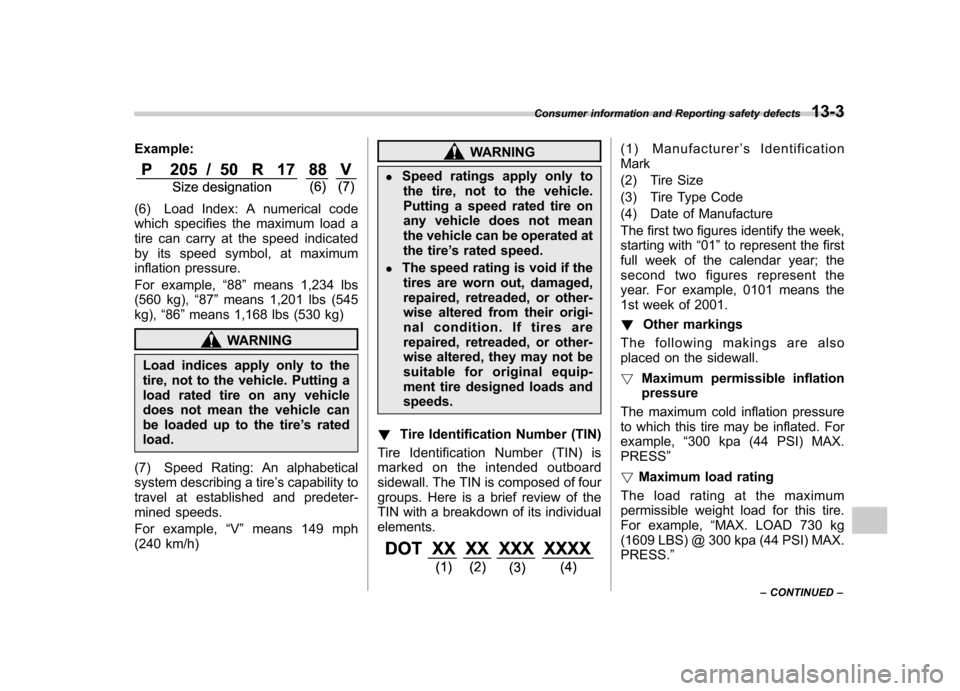
Example:
(6) Load Index: A numerical code
which specifies the maximum load a
tire can carry at the speed indicated
by its speed symbol, at maximum
inflation pressure.
For example,“88 ”means 1,234 lbs
(560 kg), “87 ”means 1,201 lbs (545
kg), “86 ”means 1,168 lbs (530 kg)
WARNING
Load indices apply only to the
tire, not to the vehicle. Putting a
load rated tire on any vehicle
does not mean the vehicle can
be loaded up to the tire ’s rated
load.
(7) Speed Rating: An alphabetical
system describing a tire ’s capability to
travel at established and predeter-
mined speeds.
For example, “V ” means 149 mph
(240 km/h)
WARNING
. Speed ratings apply only to
the tire, not to the vehicle.
Putting a speed rated tire on
any vehicle does not mean
the vehicle can be operated at
the tire ’s rated speed.
. The speed rating is void if the
tires are worn out, damaged,
repaired, retreaded, or other-
wise altered from their origi-
nal condition. If tires are
repaired, retreaded, or other-
wise altered, they may not be
suitable for original equip-
ment tire designed loads and speeds.
! Tire Identification Number (TIN)
Tire Identification Number (TIN) is
marked on the intended outboard
sidewall. The TIN is composed of four
groups. Here is a brief review of the
TIN with a breakdown of its individual
elements.(1) Manufacturer ’s Identification
Mark
(2) Tire Size
(3) Tire Type Code
(4) Date of Manufacture
The first two figures identify the week,
starting with “01 ”to represent the first
full week of the calendar year; the
second two figures represent the
year. For example, 0101 means the
1st week of 2001. ! Other markings
The following makings are also
placed on the sidewall. ! Maximum permissible inflation
pressure
The maximum cold inflation pressure
to which this tire may be inflated. For
example, “300 kpa (44 PSI) MAX.
PRESS ”
! Maximum load rating
Theloadratingatthemaximum
permissible weight load for this tire.
For example, “MAX. LOAD 730 kg
(1609 LBS) @ 300 kpa (44 PSI) MAX.
PRESS. ”
Consumer information and Reporting safety defects
13-3
– CONTINUED –
Page 419 of 442

13-4Consumer information and Reporting safety defects
WARNING
Maximum load rating applies
only to the tire, not to the
vehicle. Putting a load rated tire
on any vehicle does not mean
the vehicle can be loaded up to
the tire ’s rated load.
! Construction type
Applicable construction of this tire.
For example, “TUBELESS STEEL
BELTED RADIAL ”
! Construction
The generic name of each cord
material used in the plies (both side-
wall and tread area) of this tire.
For example, “PLIES: TREAD 2
STEEL + 2 POLYESTER + 1 NYLON
SIDEWALL 2 POLYESTER ”
! Uniform Tire Quality Grading
(UTQG)
For details, refer to “Uniform tire
quality grading standards ”in this
chapter.
Page 427 of 442

13-12Consumer information and Reporting safety defects
Uniform tire quality grading standards
This information indicates the relative
performance of passenger car tires in
the area of treadwear, traction, and
temperature resistance. This is to aid
the consumer in making an informed
choice in the purchase of tires.
Quality grades can be found where
applicable on the tire sidewall be-
tween tread shoulder and maximum
section width. For example:
Treadwear 200 Traction AA Tem-
perature A
The quality grades apply to new
pneumatic tires for use on passenger
cars. However, they do not apply to
deep tread, winter type snow tires,
space-saver or temporary use spare
tires, tires with nominal rim diameters
of 12 inches or less, or to some limited
production tires.
All passenger car tires must conform
to Federal Safety Requirements in
addition to these grades. &
Treadwear
The treadwear grade is a comparative
rating based on the wear rate of the
tire when tested under controlled
conditions on a specified government
test course.
For example, a tire graded 150 would
wear one and one-half (1-1/2) times
as well on the government course as
a tire graded 100. The relative perfor-
mance of tires depends upon the
actual conditions of their use, how-
ever, and may depart significantly
from the norm due to variations in
driving habits, service practices and
differences in road characteristics and
climate. & Traction AA, A, B, C
The traction grades, from highest to
lowest, are AA, A, B and C. Those
grades represent the tire ’s ability to
stop on wet pavement as measured
under controlled conditions on speci-
fied government test surfaces of
asphalt and concrete. A tire marked
C may have poor traction perfor- mance.WARNING
The traction grade assigned to
this tire is based on straight-
ahead braking traction tests,
and does not include accelera-
tion, cornering, hydroplaning, or
peak traction characteristics.
& Temperature A, B, C
The temperature grades are A (the
highest), B, and C, representing thetire ’s resistance to the generation of
heat and its ability to dissipate heat
when tested under controlled condi-
tions on a specified indoor laboratory
test wheel. Sustained high tempera-
ture can cause the material of the tire
to degenerate and reduce tire life, and
excessive temperature can lead to
sudden tire failure. The grade C
corresponds to a level of performance
which all passenger car tires must
meet under the Federal Motor Vehicle
Safety Standards No. 109. Grades B
and A represent higher levels of
performance on the laboratory test
wheel than the minimum required by
Page 428 of 442

law.
WARNING
The temperature grade for this
tire is established for a tire that
is properly inflated and not over-
loaded. Excessive speed, under-
inflation, or excessive loading,
either separately or in combina-
tion, can cause heat buildup and
possible tire failure. Reporting safety defects (USA)
If you believe that your vehicle has
a defect which could cause a
crash or could cause injury or
death, you should immediately in-
form the National Highway Traffic
Safety Administration (NHTSA) in
addition to notifying Subaru of
America, Inc.
If NHTSA receives similar com-
plaints, it may open an investiga-
tion, and if it finds that a safety
defect exists in a group of vehi-
cles, it may order a recall and
remedy campaign. However,
NHTSA cannot become involved
in individual problems between
you, your dealer, or Subaru of
America, Inc. To contact NHTSA,
you may call the Vehicle Safety
Hotline toll-free at 1-888-327-4236
(TTY: 1-800-424-9153); go to
http://www.safercar.gov; or write
to:Administrator,NHTSA,400
Seventh Street, SW., Washington, DC 20590. You can also obtain
other information about motor ve-
hicle safety from
http://www.safercar.gov.
Consumer information and Reporting safety defects
13-13
Page 431 of 442
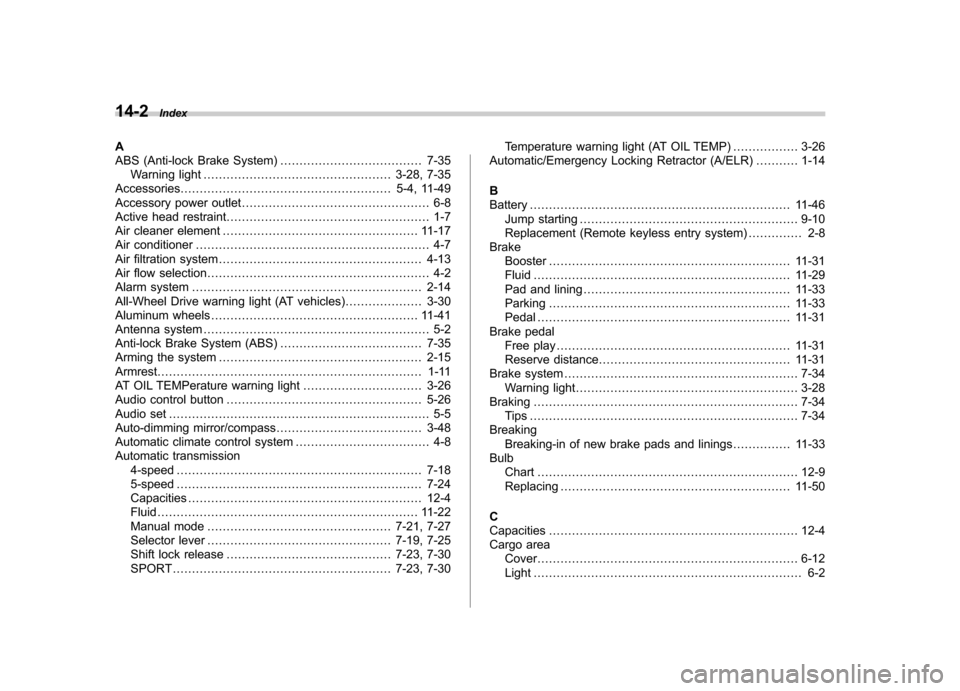
14-2Index
A
ABS (Anti-lock Brake System) ..................................... 7-35
Warning light ................................................. 3-28, 7-35
Accessories ....................................................... 5-4, 11-49
Accessory power outlet ................................................. 6-8
Active head restraint ..................................................... 1-7
Air cleaner element ................................................... 11-17
Air conditioner ............................................................. 4-7
Air filtration system ..................................................... 4-13
Air flow selection .......................................................... 4-2
Alarm system ............................................................ 2-14
All-Wheel Drive warning light (AT vehicles) .................... 3-30
Aluminum wheels ...................................................... 11-41
Antenna system ........................................................... 5-2
Anti-lock Brake System (ABS) ..................................... 7-35
Arming the system ..................................................... 2-15
Armrest ..................................................................... 1-11
AT OIL TEMPerature warning light ............................... 3-26
Audio control button ................................................... 5-26
Audio set .................................................................... 5-5
Auto-dimming mirror/compass ...................................... 3-48
Automatic climate control system ................................... 4-8
Automatic transmission 4-speed ................................................................ 7-18
5-speed ................................................................ 7-24
Capacities ............................................................. 12-4
Fluid .................................................................... 11-22
Manual mode ................................................ 7-21, 7-27
Selector lever ................................................ 7-19, 7-25
Shift lock release ........................................... 7-23, 7-30
SPORT ......................................................... 7-23, 7-30 Temperature warning light (AT OIL TEMP)
................. 3-26
Automatic/Emergency Locking Retractor (A/ELR) ........... 1-14
BBattery .................................................................... 11-46
Jump starting ......................................................... 9-10
Replacement (Remote keyless entry system) .............. 2-8
Brake
Booster ............................................................... 11-31
Fluid ................................................................... 11-29
Pad and lining ...................................................... 11-33
Parking ............................................................... 11-33
Pedal .................................................................. 11-31
Brake pedal
Free play ............................................................. 11-31
Reserve distance .................................................. 11-31
Brake system ............................................................. 7-34
Warning light .......................................................... 3-28
Braking ..................................................................... 7-34
Tips ...................................................................... 7-34
Breaking
Breaking-in of new brake pads and linings ............... 11-33
Bulb Chart .................................................................... 12-9
Replacing ............................................................ 11-50
CCapacities ................................................................. 12-4
Cargo area Cover .................................................................... 6-12
Light ...................................................................... 6-2